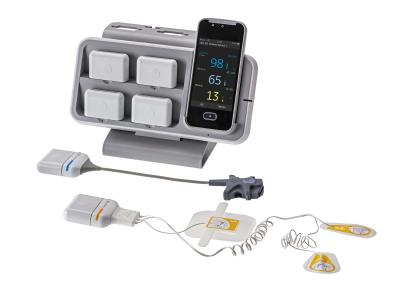More than a year after unveiling its wearable, wireless patient monitoring system—with CE mark already in hand, allowing it to be used across Europe—GE HealthCare is bringing the Portrait Mobile technology across the pond.
The system has secured FDA 510(k) clearance, the company announced Monday, allowing it to be used in hospitals in the U.S.
The regulatory nod is a major boost to GE HealthCare’s post-spinout road map: During an interview with Fierce Medtech on the early January day the company formally left the General Electric nest as a solo public entity, Catherine Estrampes, president and CEO of GE HealthCare’s U.S. and Canada division, specifically singled out the Portrait Mobile system as a high-priority area of the newly free-standing company’s R&D spending plan.

Portrait Mobile comprises a series of wearable sensors that continuously collect vital sign data from a hospitalized patient and wirelessly transmit that information to a smartphonelike monitor. The monitor’s round-the-clock readings are then automatically shared to a dashboard where clinicians can track changes in the patient’s health in real time.
The sensors include adhesive patches that are placed on the chest to monitor respiratory and pulse rate as well as wireless fingertip pulse oximeters to gather oxygen saturation readings. Because the system is wireless and relies on a monitor that can fit into a pocket or clip onto a robe or hospital gown, it’s designed to allow patients to move freely around their room or the hospital at large—which Neal Sandy, GE HealthCare’s general manager of monitoring solutions, said in the announcement is “important for recovery.”
The technology is specifically aimed at helping catch signs of a deteriorating condition as early as possible in patients who are recovering from critical care, including surgeries and stints in the intensive care unit. Traditional vital sign checks for those patients occur only every four to six hours, according to GE HealthCare, and also typically require wired connections to bulky bedside monitors.
“Many potentially serious episodes of instability are missed with intermittent vital sign assessments. Continuous vital sign monitoring might help clinicians identify patients who are having difficulty so they can provide help quickly,” Daniel Sessler, M.D., a professor and chair of outcomes research at Cleveland Clinic who is currently leading a trial evaluating Portrait Mobile, said in Monday’s announcement.
In a 2021 real-world study of the use of Portrait Mobile in a London hospital, 99% of the 27 surveyed nurses agreed the system could help them detect patient deterioration earlier than typical observation methods. Additionally, 90% said the technology’s continuous tracking helped them feel more reassured about their patients’ conditions compared to the usual spot checks.
Overall, 96% of the nurses included in the study rated GE HealthCare’s tool “good” or “very good.”